Howdy, BugFans,
The BugLady has been hitting the trails whenever she can, and she’s run into a whole bunch of old (invertebrate) friends and a few new ones. Here are some of the critters she’s encountered, along with links to old BOTWs where they were the stars of the show.
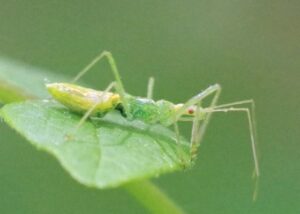
As their name suggests, ASSASSIN BUGS (in this case, a nymph in the genus Zelus) are confirmed carnivores. In his Bug Eric blog, entomologist Eric Eaton calls the genus Zelus the “sundew assassin bugs.” In his words, “The tibiae (“shins”) of the front legs (and to some degree the middle legs) are densely covered in short hairs, and this is part of their secret weapon. Special glands in the exoskeleton of the legs secrete a glue-like material that the insect intentionally smears over those hairs. This creates a sticky layer that small prey cannot escape once the assassin grabs them. When they hatch from the egg, nymphs do not have the ability to produce the glue they need. No matter, mom has covered the egg cluster in sticky goo to repel egg parasites like tiny wasps, and the nymphs simply wipe their “arms” along the base of the egg mass to gather some glue.” Sometimes, other things stick to them, too .
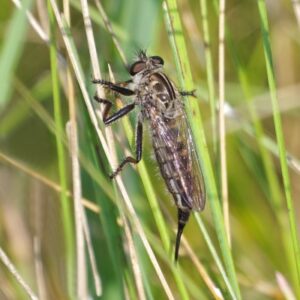
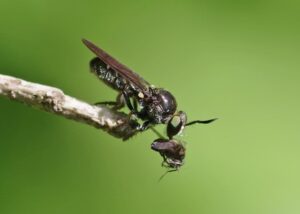
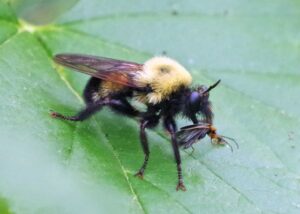
ROBBER FLIES are awesome predators that come in all shapes and sizes, and they catch and eat a wide variety of insect prey, including other robber flies. Most pursue and snatch insects from the air and fly to a perch to feed on them. To this end, they inject a cocktail of toxins to subdue their prey and tissue softeners to make it more “sippable.” Their courtship technique resembles their hunting technique, minus the injection part. If you hear an annoyed buzz as you walk through a field, you probably disturbed a robber fly. For information about Wisconsin robber flies, see https://wisconsinbutterflies.org/robberfly .
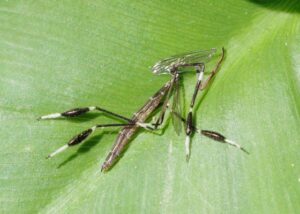
The BugLady loves to watch PHANTOM CRANE FLIES flicker through low vegetation along the edges of wetlands. Apparently, she’s not the only one – some predator enjoyed a meal, here, probably sucking out the innards and leaving the roughage. This is what they look like when they’re assembled.
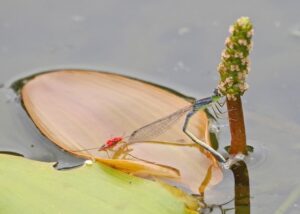
The slate-blue, mature female EASTERN FORKTAIL DAMSELFLY is ovipositing into a Potamogeton pondweed – making a little slice that she will put her egg into. Next June, when her aquatic offspring climb up onto Potamogeton flower stalks to shed their skins and become adults, the circle will be completed.
But she is only part of this wetland tableaux. The red dots at the water’s surface are water mites on a water strider. Nymphal water mites act like ticks, attaching themselves to anything they can catch up with. A few mites don’t present a problem for their host, but a big load can sap its strength.
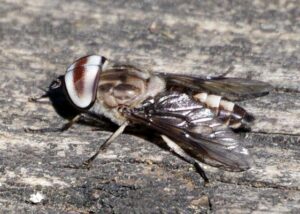
THREE-SPOTTED/WHITE-SPOTTED HORSE FLY – The BugLady loves finding these lunker horse flies. The males get the cool (and oversized) eyes.
This fly was named by Ambroise Marie François Joseph Palisot, Baron de Beauvois (1752 to 1820), who seems to have had more than his share of bad luck. A French botanist and entomologist, he was one of the first to discover and describe some American insects, though unfortunately, he ascribed to America some insects that he had collected in Africa. Specimens that he collected in Nigeria were destroyed during a siege there, and then he caught yellow fever. After recovering in Haiti, more of his collection burned in the Haitian Revolution (which he was on the wrong side of) (as a nobleman, he was also on the wrong side of the French Revolution). He set sail from Haiti for the United States and was robbed on shipboard, arriving on these shores with nothing, and he worked in a circus to keep body and soul together. When he decided that France was safe for him to live in again, he sent collections there in anticipation of his return, but one shipment was lost in a shipwreck. Back in France, he became a prolific writer and illustrator, but little of his insect collections remain.
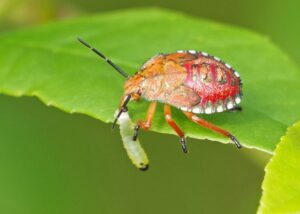
STINK BUG NYMPH – Lots of stink bugs are pests of plants. This Apoecilus nymph is decidedly not, and neither is its adult. Random Fact about this genus from bugguide.net : “often collected washed ashore in MI.”
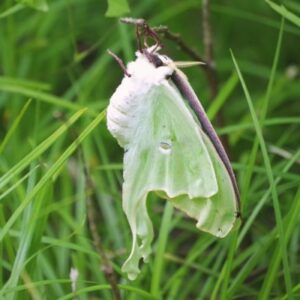
The BugLady would give her heart to the LUNA MOTH if she had not already given it to the Tiger Swallowtail (it’s a close second, though). Named “Luna” for the moon-shaped spots on its wings, the moth has a 3” to 4”-plus wingspan. Adults live only to mate. Caterpillars defend themselves by clicking, followed by “defensive regurgitation.” The pupal case has a clear “window” woven into it, through which the developing moth can gauge day length, so it can emerge at the right time in spring. The BugLady is not sure whether this moth was just starting or just ending her journey. Good spotting, BugFan John!
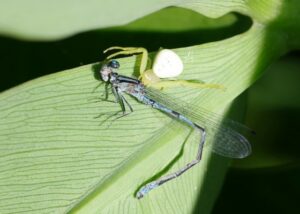
CRAB SPIDER WITH BLUET DAMSELFLY – dining al fresco – immediate seating is available on the arrow arum leaf.
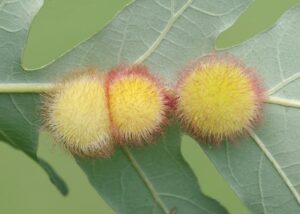
OAK HEDGEHOG GALL – Funny-looking swellings on plants are usually galls, which are caused by the interference by insects or mites in the normal growth of the plant. An author on the University of Kentucky Urban Forest Initiative website’s “Tree Talk” aptly calls them “cell pirates,” because they redirect the cell growth, causing the plant to grow a little home for them. Oaks have lots of galls, and many of them are triggered by tiny cynipid wasps. The Hedgehog gall wasp (Acraspis erinacei) caused this one on white oak. For more information about galls, try https://uwm.edu/field-station/galls-i/ and https://josm.geneseo.edu/1-1/00-05.pdf .
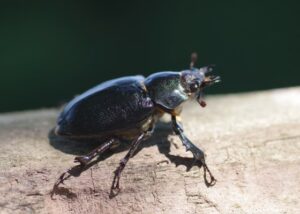
While it’s not one of the more spectacular American STAG BEETLES (like here and here ), Lucanus placidus is big enough to get your attention (here’s the male ). It’s found in gardens, lawns, and sandy open areas, where males sometimes fight each other.
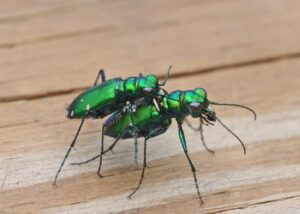
SIX-SPOTTED TIGER BEETLES ensuring the next generation.
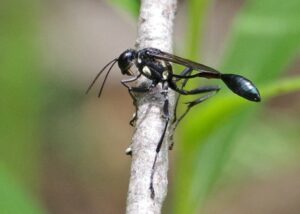
GOLD-MARKED THREAD-WAISTED WASPS grace the eastern half of North America. A wasp’s “waist” is the result of a constriction of the first (and sometimes the second) abdominal segment and is called the petiole (the bulk of the abdomen is called the gaster). Thread-waisted wasps carry petioles to an extreme, but the petiole is thought to give wasps more flexibility in egg-laying. Females dig burrows for their egg chambers and provision each chamber with a single, large (sometimes so large that they have to drag it home), stunned caterpillar for their eventual larva to eat.
Go outside – Look at bugs!
The BugLady